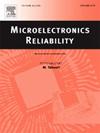弯曲-扭转耦合载荷下WLCSP焊点应力-应变分析与预测
IF 1.6
4区 工程技术
Q3 ENGINEERING, ELECTRICAL & ELECTRONIC
引用次数: 0
摘要
随着电子元件小型化的趋势,晶圆级晶片封装(WLCSP)芯片以其紧凑的尺寸被广泛应用于各种电子器件。在这些设备的操作过程中,它们不可避免地要承受弯曲和扭转载荷,例如智能手机屏幕的频繁触摸,笔记本电脑屏幕的打开和关闭动作以及键盘输入。研究WLCSP焊点的应力应变对焊点的可靠性设计至关重要,从而提高电子器件的整体可靠性。因此,本研究建立了WLCSP焊点的有限元模型,对其在弯曲-扭转耦合载荷下的应力应变进行了有限元分析。建立了弯曲-扭转耦合加载下WLCSP焊点应变测试平台,并进行了应变测量试验,验证了仿真结果的准确性。选取WLCSP焊点的3个结构参数——焊点直径、焊盘直径和焊点高度作为影响因素。采用正交设计方法,设计了16种不同结构参数水平组合的WLCSP焊点,获得了最大弯曲-扭转耦合应力,并对最大应力进行了极差和方差分析。建立了WLCSP焊点弯曲-扭转耦合应力的粒子群优化- BP神经网络预测模型,对焊点的弯曲-扭转耦合应力进行预测。结果表明,在焊点直径、焊盘直径和焊点高度3个结构参数中,它们对WLCSP焊点弯扭耦合应力的影响排序为:焊点高度>;焊点直径>;垫直径。当置信水平为95%时,焊点高度和焊点直径对WLCSP焊点的弯曲-扭转耦合应力有显著影响。建立的PSO-BP神经网络模型用于预测WLCSP焊点弯曲-扭转耦合应力,最大预测误差为5.58%,平均误差为3.01%,具有较好的应力预测精度。本文章由计算机程序翻译,如有差异,请以英文原文为准。
Stress–strain analysis and prediction of WLCSP solder joints under bending–torsion coupled loading
With the trend of miniaturization in electronic components, Wafer-Level Chip Scale Package(WLCSP) chips, known for their compact size, are widely used in various electronic devices. During the operation of these devices, they are inevitably subjected to bending and torsional loads, such as frequent touches on smartphone screens, the opening and closing actions of laptop screens, and keyboard typing. Research on the stress and strain of WLCSP solder joints is crucial for the reliability design of these joints, thereby enhancing the overall reliability of electronic devices. Therefore, this study establishes a finite element model of WLCSP solder joints and conducts a finite element analysis of their stress and strain under bending–torsion coupling loads.A strain testing platform for WLCSP solder joints under bending–torsion coupled loading was developed, and strain measurement tests were performed to verify the accuracy of the simulation results. Three structural parameters of the WLCSP solder joint — solder joint diameter, pad diameter, and solder joint height — were selected as influencing factors. Using the orthogonal design method, 16 different combinations of structural parameter levels for the WLCSP solder joints were designed to obtain the maximum bending–torsion coupled stress, followed by range and variance analysis of the maximum stress. A particle swarm optimization (PSO)–Back Propagation(BP) neural network prediction model for the bending–torsion coupled stress of the WLCSP solder joint was developed to predict the stress. The results indicate that, among the three structural parameters — solder joint diameter, pad diameter, and solder joint height — the ranking of their influence on the WLCSP solder joint bending–torsion coupled stress is as follows: solder joint height solder joint diameter pad diameter. When the confidence level is 95%, solder joint height and solder joint diameter have a significant impact on the bending–torsion coupled stress of the WLCSP solder joint. The established PSO-BP neural network model for predicting the bending–torsion coupled stress of the WLCSP solder joint shows a maximum prediction error of 5.58% and an average error of 3.01%, demonstrating a good prediction accuracy for the stress.
求助全文
通过发布文献求助,成功后即可免费获取论文全文。
去求助
来源期刊

Microelectronics Reliability
工程技术-工程:电子与电气
CiteScore
3.30
自引率
12.50%
发文量
342
审稿时长
68 days
期刊介绍:
Microelectronics Reliability, is dedicated to disseminating the latest research results and related information on the reliability of microelectronic devices, circuits and systems, from materials, process and manufacturing, to design, testing and operation. The coverage of the journal includes the following topics: measurement, understanding and analysis; evaluation and prediction; modelling and simulation; methodologies and mitigation. Papers which combine reliability with other important areas of microelectronics engineering, such as design, fabrication, integration, testing, and field operation will also be welcome, and practical papers reporting case studies in the field and specific application domains are particularly encouraged.
Most accepted papers will be published as Research Papers, describing significant advances and completed work. Papers reviewing important developing topics of general interest may be accepted for publication as Review Papers. Urgent communications of a more preliminary nature and short reports on completed practical work of current interest may be considered for publication as Research Notes. All contributions are subject to peer review by leading experts in the field.
 求助内容:
求助内容: 应助结果提醒方式:
应助结果提醒方式:


